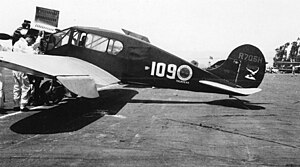The Bullet Monoplane or Alexander Eaglerock Bullet was a low wing cabin monoplane that was a departure from traditional biplane aircraft of the era.
| Bullet Monoplane | |
|---|---|

| |
| Role | Cabin monoplane |
| National origin | United States |
| Manufacturer | Alexander Aircraft Company |
| Designer | Albert Mooney |
| First flight | February 1929 |
| Introduction | 1929 |
| Number built | 11 |
Design and development
editThe Bullet was built at the beginning of the Great Depression. Company owner J Don Alexander said he was inspired by ducks tucking in their legs to build a retractable landing gear-equipped aircraft.[1] The aircraft experienced stability problems in spin testing, killing two pilots.[2] Few orders were delivered.[3]
The Bullet was a low wing, cabin aircraft with retractable conventional landing gear.[4] The fuselage was constructed with welded steel tubing and the wings were constructed with wooden spars and ribs, both with aircraft fabric covering.[5]
Operational history
editAn Alexander Eaglerock Bullet competed in the 1929 National Air Races.[6] Female pilot Jessie "Chubbie" Keith-Miller won two transcontinental air races piloting an Alexander Eaglerock Bullet.[7]
Variants
editData from: Aerofiles[8]
- Eaglerock Bullet C-1
- Powered by a Wright J-6 Whirlwind
- Eaglerock Bullet C-3
- Powered by a Kinner K-5
- Eaglerock Bullet C-4
- Powered by a 165 hp (123 kW) Wright J-6 5-cylinder radial (optional 165 hp (123 kW) Comet 7-E or 150 hp (112 kW) Axelson-Floco B)
- Eaglerock Bullet C-5
- Powered by a 165 hp (123 kW) Wright J-6 5-cylinder radial (optional 165 hp (123 kW) Comet 7-E or 150 hp (112 kW) Axelson-Floco B)
- Eaglerock Bullet C-7
- Aerodynamically improved - ATC#318 issued on 6 May 1930.[9]
Specifications (C-7 Bullet)
editData from American Airplane Specifications[10]
General characteristics
- Crew: 1
- Capacity: 3 passengers
- Length: 26 ft 10 in (8.18 m)
- Wingspan: 36 ft 0 in (10.97 m)
- Height: 7 ft 9 in (2.36 m)
- Wing area: 208 sq ft (19.3 m2)
- Empty weight: 1,720 lb (780 kg)
- Gross weight: 2,780 lb (1,261 kg)
- Fuel capacity: 44 US gal (170 L; 37 imp gal)
- Powerplant: 1 × Wright J-6 Whirlwind 7-cylinder air-cooled radial engine, 165 hp (123 kW)
Performance
- Maximum speed: 148 mph (238 km/h, 129 kn)
- Cruise speed: 122 mph (196 km/h, 106 kn)
- Stall speed: 45 mph (72 km/h, 39 kn)
- Range: 560 mi (900 km, 490 nmi)
- Service ceiling: 17,000 ft (5,200 m)
- Rate of climb: 700 ft/min (3.6 m/s)
References
edit- ^ Denver Posse. The Denver Westerners brand book. p. 246.
- ^ Terry Gwynn-Jones. The air racers: aviation's golden era, 1909-1936. p. 185.
- ^ Donald M. Pattillo. A History in the Making: 80 Turbulent Years in the American General Aviation Industry. p. 8.
- ^ Flying Magazine: 108. August 1985.
{{cite journal}}: CS1 maint: untitled periodical (link) - ^ Aeronautics: 28. September 1929.
{{cite journal}}: CS1 maint: untitled periodical (link) - ^ Joseph P. Juptner. U.S. Civil Aircraft Series, Volume 8. p. 64.
- ^ Colin Evans. A Question of Evidence: The Casebook of Great Forensic Controversies. p. 62.
- ^ Eckland, K.O. "Alexander". aerofiles.com. Retrieved 10 June 2020.
- ^ Joseph P. Juptner. U.S. civil aircraft, Volume 4. p. 65.
- ^ Aviation July 1931, pp. 428, 431.
- Miller, Ralph N. (January 1939). "Remember the Bullet?". Popular Aviation. Vol. XXIV, no. 1. pp. 33, 76–78.
- "Table 2: American Airplane Specifications: Passenger Planes With Seats For More Than Three Persons". Aviation. Vol. 30, no. 7. July 1931. pp. 428, 431.
External links
edit- Bullet Project Archived 2016-03-03 at the Wayback Machine